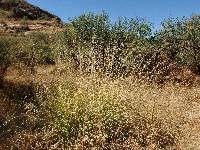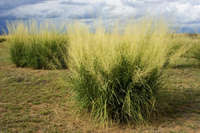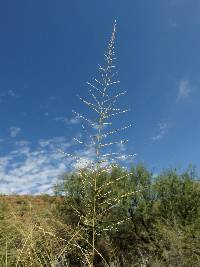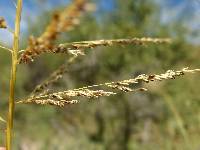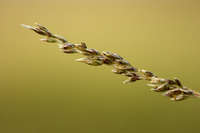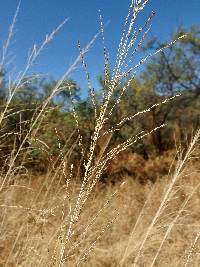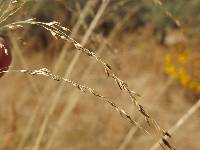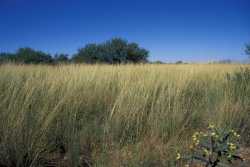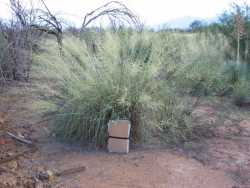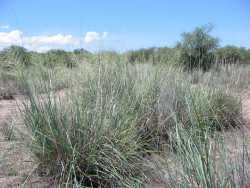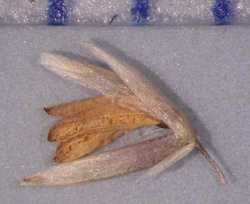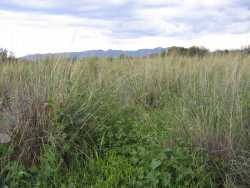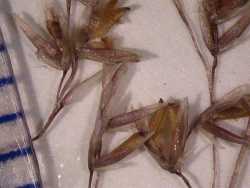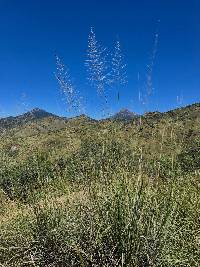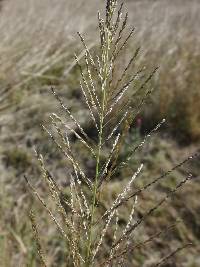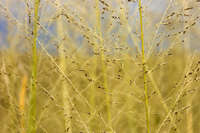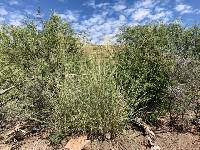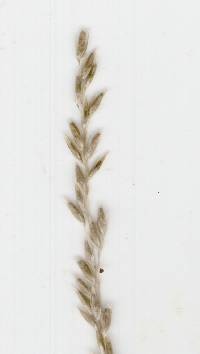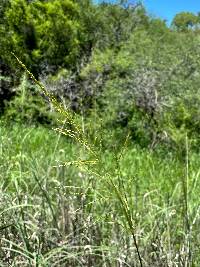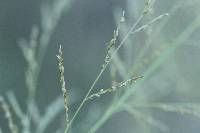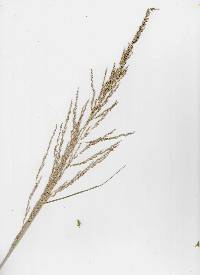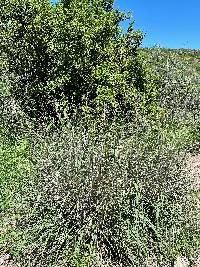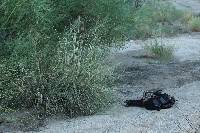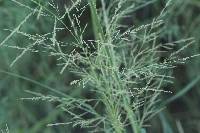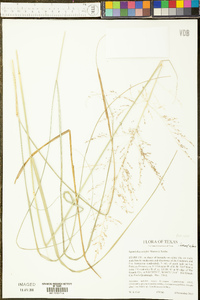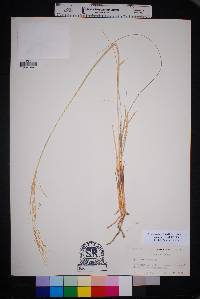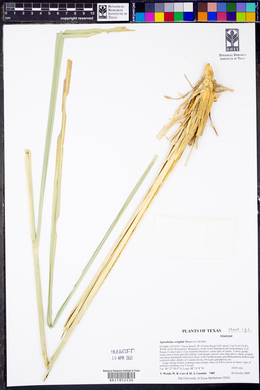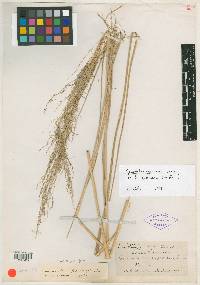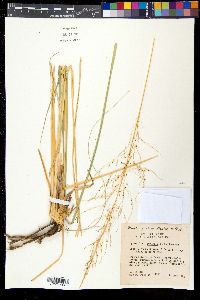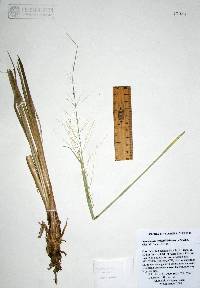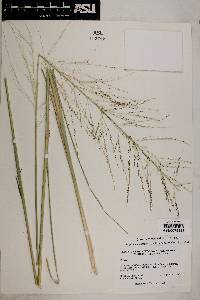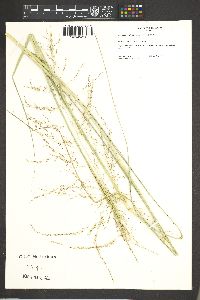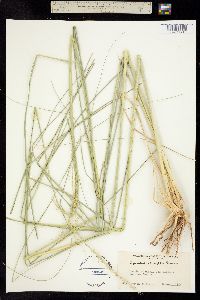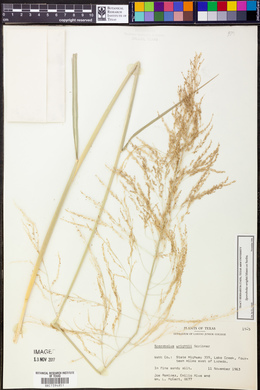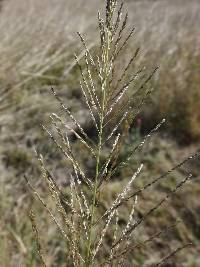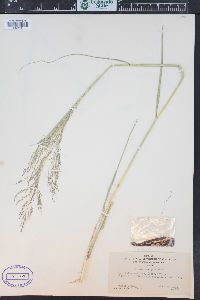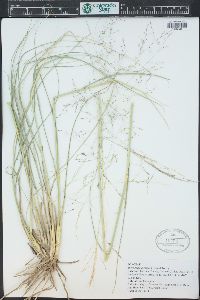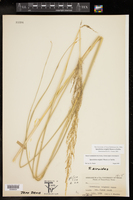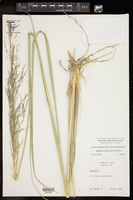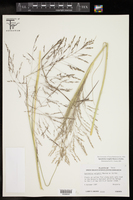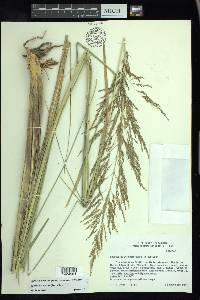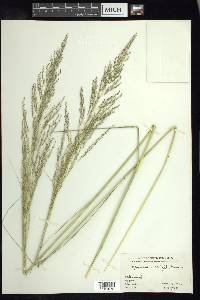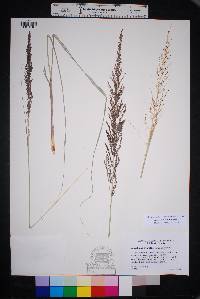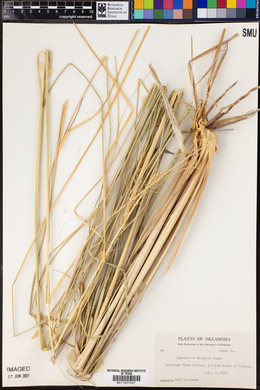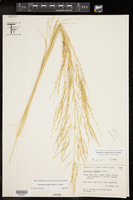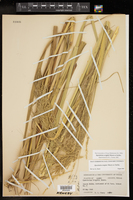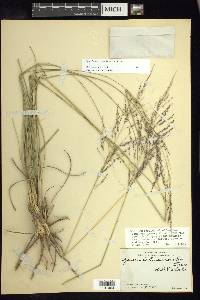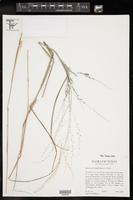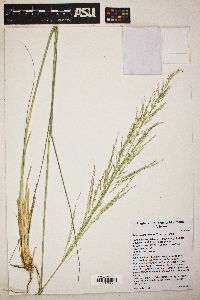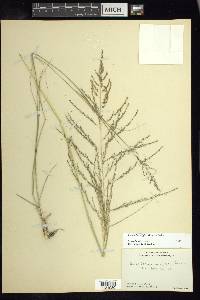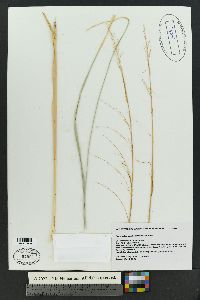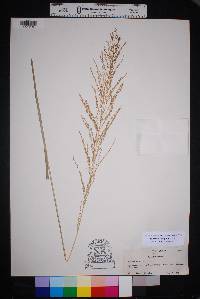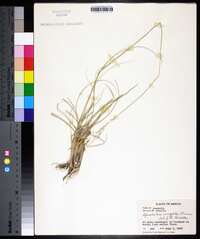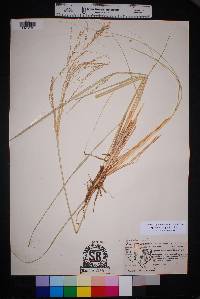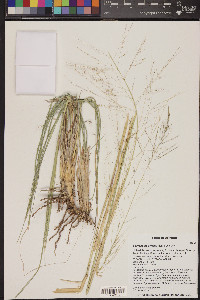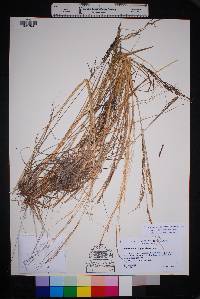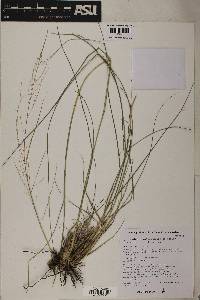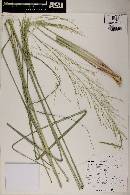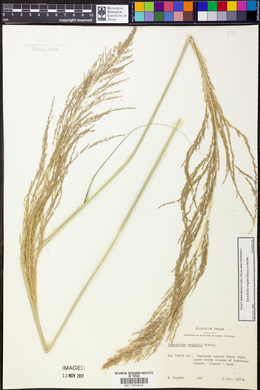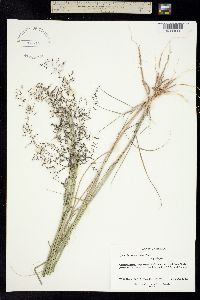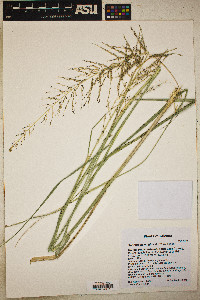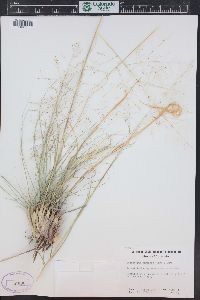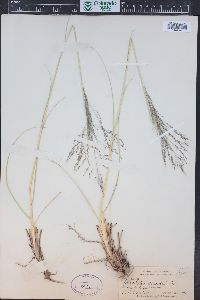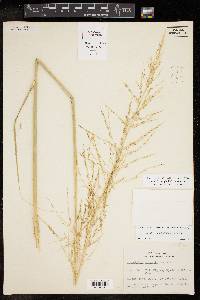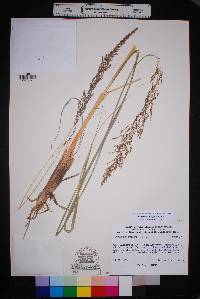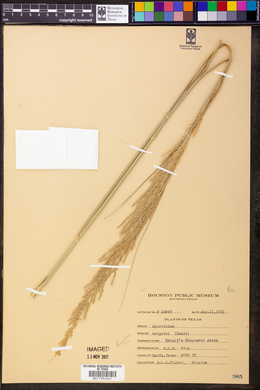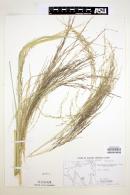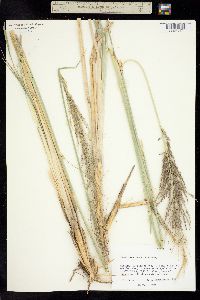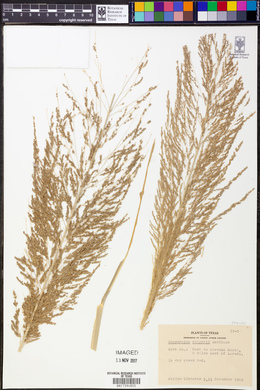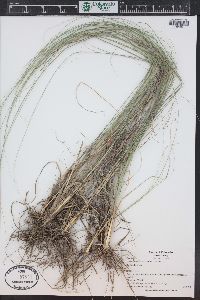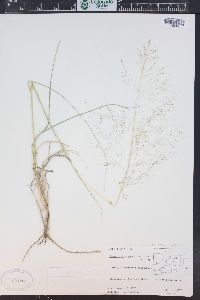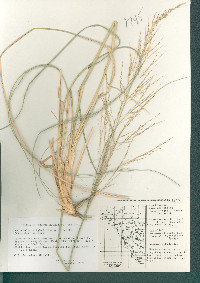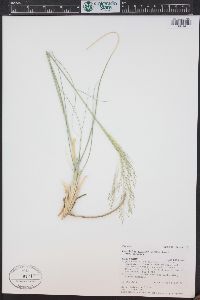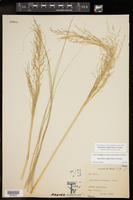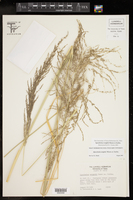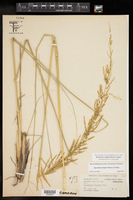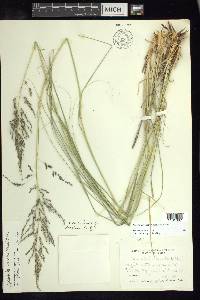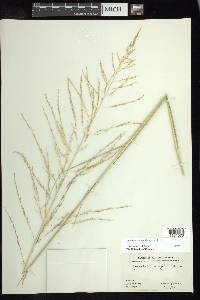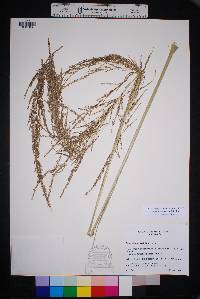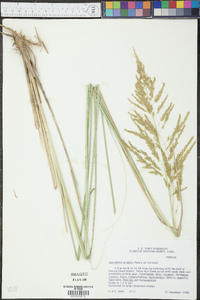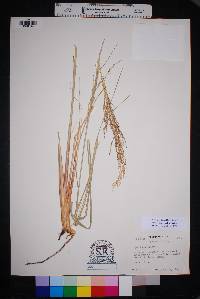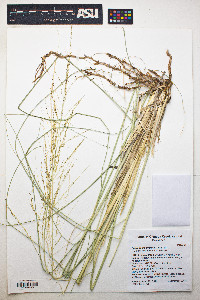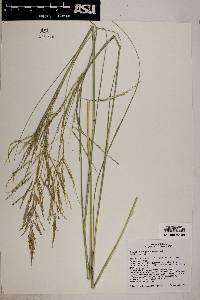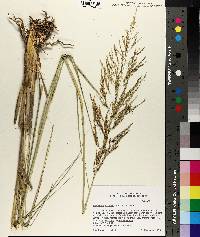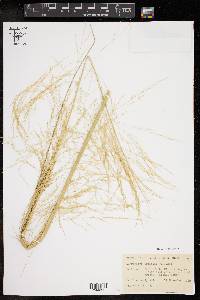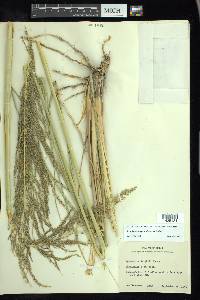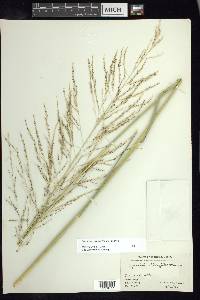
|
|
|
|
Family: Poaceae
big sacaton, more...Wright's Dropseed, sacaton, giant sacaton, Big Alkali Sacaton (es: zacatón)
[Epicampes crassiculmis Piper, moreSporobolus airoides var. minor (Vasey) Beetle, Sporobolus airoides var. wrightii (Munro ex Scribn.) Gould, Sporobolus altissimus Vasey, Sporobolus altissimus var. minor Vasey, Sporobolus eminens J. Presl, Sporobolus expansus] |
Plants perennial; cespitose, not rhizomatous. Culms 90-250 cm, stout. Sheaths rounded below, shiny, glabrous, rarely sparsely hairy apically, hairs to 6 mm; ligules 1-2 mm; blades 20-70 cm long, 3-10 mm wide, flat (rarely involute), glabrous abaxially, scabrous adaxially, margins scabrous; flag blades ascending. Panicles 20-60 cm long, 12-26 cm wide, open, broadly lanceolate, exserted; primary branches 1.5-10 cm, spreading 20-70° from the rachis; secondary branches appressed, spikelet-bearing to the base; pulvini glabrous; pedicels 0.2-0.5 mm, mostly appressed. Spikelets 1.5-2.5 mm, crowded, purplish or greenish. Glumes unequal, lanceolate to ovate, membranous; lower glumes 0.5-1 mm, often appearing veinless; upper glumes 0.8-2 mm, 2/3 or more as long as the florets; lemmas 1.2-2.5 mm, ovate, membranous, glabrous, acute to obtuse; paleas 1.1-2.5 mm, ovate, membranous, glabrous; anthers 1.1-1.3 mm, yellowish to purplish. Fruits 1-1.4 mm, ellipsoid, reddish-brown or blackish, striate. 2n = 36. Sporobolus wrightii grows in moist clay flats and on rocky slopes near saline habitats, at elevations of 5-1800 m. Its range extends to central Mexico. Dr. David Bogler, USDA NRCS PLANTS Database Perennials, Terrestrial, not aquatic, Stems nodes swollen or brittle, Stems erect or ascending, Stems caespitose, tufted, or clustered, Stems terete, round in cross section, or polygonal, Stem internodes hollow, Stems with inflorescence less than 1 m tall, Stems with inflorescence 1-2 m tall, Stems with inflorescence 2-6 m tall, Stems, culms, or scapes exceeding basal leaves, Leaves mostly cauline, Leaves conspicuously 2-ranked, distichous, Leaves sheathing at base, Leaf sheath mostly open, or loose, Leaf sheath smooth, glabrous, Leaf sheath and blade d ifferentiated, Leaf blades linear, Leaf blades 2-10 mm wide, Leaf blades mostly flat, Leaf blade margins folded, involute, or conduplicate, Leaf blades mostly glabrous, Ligule present, Ligule a fringe of hairs, Inflorescence terminal, Inflorescence simple spikes, Inflorescence an open panicle, openly paniculate, branches spreading, Inflorescence solitary, with 1 spike, fascicle, glomerule, head, or cluster per stem or culm, Inflorescence branches more than 10 to numerous, Flowers bisexual, Spikelets pedicellate, Spikelets laterally compressed, Spikelet less than 3 mm wide, Spikelets with 1 fertile floret, Spikelets solitary at rachis nodes, Spikelets all alike and fertille, Spikelets bisexual, Spikelets disarticulating above the glumes, glumes persistent, Rachilla or pedicel glabrous, Glumes present, empty bracts, Glumes 2 clearly present, Glumes distinctly unequal, Glumes shorter than adjacent lemma, Glumes 1 nerved, Lemmas thin, chartaceous, hyaline, cartilaginous, or memb ranous, Lemma similar in texture to glumes, Lemma 1 nerved, Lemma glabrous, Lemma awnless, Lemma straight, Palea present, well developed, Palea membranous, hyaline, Palea about equal to lemma, Palea 2 nerved or 2 keeled, Stamens 3, Styles 2-fid, deeply 2-branched, Stigmas 2, Fruit - caryopsis, Caryopsis ellipsoid, longitudinally grooved, hilum long-linear.
FNA 2003, Gould 1980 Common Name: big sacaton Duration: Perennial Nativity: Native Lifeform: Graminoid General: Large, coarse-stemmed perennial bunchgrass, 1-2 m tall; stems 4-6 mm thick at base. Vegetative: Sheath open, rounded, glabrous, one margin occasionally slightly ciliolate near collar; collar glabrous, a few hairs at margins; blades 3-6 mm wide, 20-60 cm long, flat to involute, sparsely pilose at base behind ligule, with a prominent midvein; ligule c Inflorescence: Open, loosely branched panicle mostly 35-60 cm long, narrow, densely flowered; primary branches ascending; secondary branches closely appressed to primary branches, densely flowered nearly to base; spikelets 2 mm long, 1-flowered, purplish or greenish; first glume 1 mm, second glume 2 mm; lemmas 1-2 mm, ovate, membranous. Ecology: River banks, sandy washes, plains, valley flats, and floodplains; 2,000-6,500 ft (610-1981 m); flowers March-November. Distribution: s CA, UT, AZ, east to OK and TX; south to s MEX. Notes: Sporobolus species have single-seeded spikelets with unequal glumes, no awns, and most often small seeds which readily fall after maturing hence the common name "dropseed." One of the largest grasses in the region, this species often forms clumps of fountain-like grass more than 1 m in diameter and can grow to 2 m tall. It has an open panicle and pedicels and spikelets which are appressed to branches of the inflorescence. S. wrightii is an interesting species ecologically, as a shrub-sized grass that can be dominant on a landscape. It is restricted to floodplains due to its need to access groundwater for survival. It was much more abundant and common historically, covering valley bottoms that have since been overgrazed, plowed up for agriculture, dewatered by groundwater pumping, or transitioned to cottonwood-willow gallery forest after massive floods circa 1900 initiated arroyo cutting throughout the southwest. Ethnobotany: Seeds were made into meal for bread, for mush, and the stiff stems were made into a brush to clean cacti spines. Synonyms: Sporobolus airoides var. wrightii Editor: SBuckley 2010, FSCoburn 2014, AHazelton 2015 Etymology: Sporobolus is Greek for "seed-caster" while wrightii honors William Greenwood Wright (1831-1912) a Californian lepidopterist. |
|
|
|


